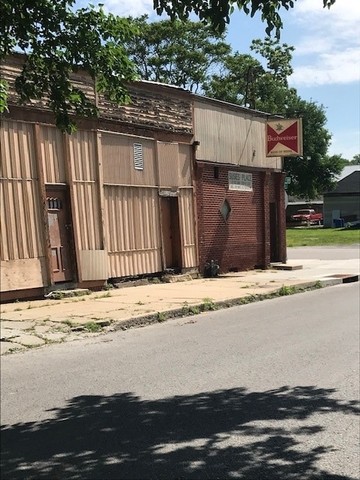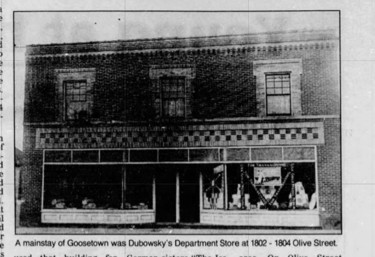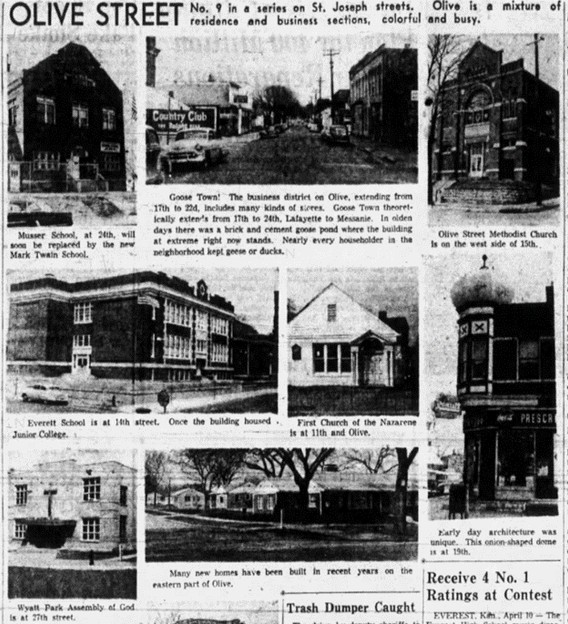Goosetown
Introduction
Text-to-speech Audio
The Polish community was centered largely in the Goosetown neighborhood. For the Poles, the primary street was Warsaw Street. Most of the Polish community worked either in the packing houses of South St. Joseph or at Devil’s Backbone, a substantial brickyard located behind St. Patrick’s Church. Others made their livings in the garment factories in downtown. For those who worked in the Southside, transportation from the Goosetown neighborhood to work was difficult. Though there were streetcars running down Messanie Street to the packing house district, most of these workers could not afford to ride them. This prompted some of them to move further south to be closer to their jobs. They established St. Stanislaus Church. The move to the Southside marked the end of the ethnically homogenous community; once there they began to intermarry with the many other groups who lived and worked in that part of St. Joseph.
Images
1802-1804 Olive St., site of Dubowsky's Department store

1927 Olive St.

Dubowsky's Department Store

1954 pictorial on Goosetown

Backstory and Context
Text-to-speech Audio
Goosetown, a neighborhood between Messanie and Lafayette Streets and 17th and 22nd Streets, was an enclave of Poles, Germans, and Swedes in the pre-World War I period. The name came from the large number of residents who raised geese. This neighborhood had the feel of an agricultural village. In addition to raising geese, most residents had their own gardens, smokehouses, and raised chickens. Life in Goosetown was lively and vibrant. Between 1896 and 1908 they had their own baseball team known as the Goose Town Sluggers. The area was known for being a bit unruly.
The primary street in Goosetown was Olive Street; a glance at the City Directories for the first years of the 20th century gives a wonderful idea of the density and diversity of the area. Olive Street was mixed residential and commercial, with most blocks containing a mixture of both uses. A walk down the street in 1909 would have taken you past the establishments of shoemakers, painters, Blacksmiths, barbers, clothing merchants (both new and second hand), drug stores and pharmacies, fuel and feed, cigar manufacturers, and a sheet metal fabricator. And if it was food or drink you were after; Olive Street was the place to get it! Nearly every block had a neighborhood grocery, there were several saloons, multiple meat merchants, confectioners, and even an ice cream cone manufacturer. These enterprises were owned and operated by people of varying backgrounds, many from Eastern Europe.
One of the best-known families in Goosetown was the Borkowskis. Antoine, born in 1887 in St. Joseph, one of 24 children of his Polish parents. Antoine began his career as a saloon keeper in the packing house district of the Southside. But in the 19teens he opened his own saloon in the heart of Goosetown, at 1927 Olive St.
On the 1800 block of the street were two businesses operated by the Frank Dubowskys – Sr. and Jr. At 1818 they operated a meat market and at 1802-04 a grocery and meat market and the family lived above the shop. Frank Sr. was born in Bohemia, as was his wife Verona. The couple married in 1865 and came to the United States in 1867. The 1900 census shows them living at 1802 Olive Street with seven children between the ages of 9 and 22 (there were two older children who no longer lived with the family). All of the children were born in Missouri. The family were parishioners at SS Peter and Paul Church. In November 1904, Frank Jr. died at the age of 29 of typhoid.[1]
An event on February 15, 1904 illustrates a great deal about the character of Goosetown. That night William Dubowsky, Frank Sr.’s 19-year old son was arrested in the company of Harry Gray, an African American on charges of robbing Paul Szopieray Jr. of $35 in cash and some jewelry in an Olive St. saloon. In order to get a confession, the young suspects were “put through the sweat box.” “According to the facts learned by the officers, Szopieray was found in the closet drunk, by the two men. They carried him into the wine room and laying him on the floor, went through his pockets, taking all his valuables.”
Today, Goosetown is a shadow of its former self, but if you look carefully you can find traces of what was once a vibrant and unique neighborhood. The saloon operated by Antoine Borkowski at 1927 Olive St. is still there – and you can still get a beer! If you peer behind and above the recent vinyl cladding at the storefront with living accommodation on the second floor at 1802 Olive St. where the Dubowskys worked and lived, it is possible to imagine the role it played in the life of this neighborhood.
[1] An examination of the St. Joseph Death Record Database for the year 1904 shows that this cause of death was very unusual.
Sources
Kimberly Schutte, “The Eastern European Immigrant Community of St. Joseph, Missouri, c. 1850-1950,” https://www.stjosephmo.gov/DocumentCenter/View/14841/Eastern-European-Immigrant-Community-of-St-Joseph-MO-PDF?bidId= “Feud of a Village,” St. Joseph News Press, Feb. 11, 1896, pg. 7; “A Boy’s Escapade,” St. Joseph Herald, Sept. 5, 1897, pg. 5; “Accused of Stealing Pups,” St. Joseph News Press, Oct. 16, 1899, pg. 5; “’Rolled’ Drunken Man; Arrested,” St. Joseph News Press, Feb. 16, 1904, pg. 10.
St. Joseph News Press
